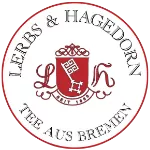- You do not have any products in your shopping cart yet.
Buy East Frisian Tea online
Buy the best East Frisian Tea Blends from 1,5 kg online at Lerbs & Hagedorn from Bremen
Did you know?
East Frisian tea
In East Frisia, the enjoyment of tea has developed into a real passion over the past centuries. As a result, the East Frisian tea known as tea blends are now very popular in all parts of Germany and worldwide. In combination with the rituals of East Frisian tea culture, the intense aroma in particular makes East Frisian tea an unforgettable taste experience.
History of East Frisian tea
The East Frisians' love affair with tea began as early as the 17th century. At that time, seafarers brought tea leaves from the Indian colonies to Europe and thus to East Frisia for the first time. Once they had acquired a taste for it, the East Frisian tea soon even replaced the previously widespread beer as the favourite drink. Over the course of many generations, the East Frisians defended theirnational drink against the decisions of kings, the Continental Blockade imposed by Napoleon and high taxes on tea. This even went so far that there was a lively exchange of tea for other goods between the miners of the Ruhr, who received tea allowances, and the East Frisians.
Making East Frisian tea
The name East Frisian tea can sometimes be very misleading, as the tea does not have to be grown or produced in East Frisia to bear this name. What distinguishes all East Frisian teas, however, is the fact that they are blends of different black-tea varieties. However, only teas blended in Friesland can be called original or genuine, all others bear additions such as East Frisian style. By using different types of tea from different growing areas in Asia and Africa, the East Frisian tea producers were already able to compensate for harvest shortfalls and poorer quality. With up to 20 different types of tea, the taste remains relatively unchanged due to the different weighting of the individual varieties.
Taste and preparation of East Frisian tea
One of the varieties found in virtually every East Frisian tea remains, as in earlier centuries, the assam originating from India. The gentle drying process refines the flavour and does not lose any of its strong taste during transport. The Darjeeling, which also comes from India, should not be missing from any East Frisian tea blend. Its aroma is somewhat milder, but it gives the colour of East Frisian tea an almost golden shimmer that makes a cup of tea a visual experience. In addition, the ceylon tea from Sri Lanka provides a fresh acidity that perfectly matches the honey-like flavour of the Assam.
The taste of East Frisian tea is not only related to the blending ratio of the individual varieties, but also to the way it is prepared. In East Frisia, it is typical to use only soft water, as chalky water is also reflected in the taste. Instead of using pre-packed tea bags, it is better to use a small teapot or even brew it without any aids at all when preparing East Frisian tea. Then the finished East Frisian tea can simply be transferred to a second teapot via a tea strainer after preparation. Using a teapot for brewing is a must, as this is the only way to create an even patina that gives the flavour that certain something. To achieve this, it is sufficient to rinse the pot briefly with water and then gently remove any remaining moisture with a cup of tea. East Frisian tea of very good quality already achieves a taste after three minutes that has a very stimulating effect on the body. After about five minutes, the East Frisian tea is darker in colour, but also a little rounder, which makes the stimulating effect fade into the background.
Refining East Frisian tea
Simply preparing East Frisian tea and then drinking it thoughtlessly would be unthinkable for a true East Frisian. So it is not least the East Frisian tea culture, which has been cultivated for generations, that ensures that this pleasure can also be celebrated. Comparable to the English 5 o'clock tea, here too every family has its own tea set. Unlike with milk, however, the East Frisians love their tea with cream and use rock candy to sweeten the tea mixture. The resulting cream puffs take on different shapes each time and are considered the hallmark of an original East Frisian tea.
Customer service
If you have any questions about our East Frisian tea blends, need further information on sales processing or would like to give us feedback, one of our staff will be happy to assist you.
Service hotline: 0172/ 9149105.
1 to 28 (from a total of 29)

